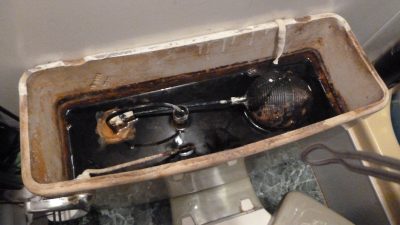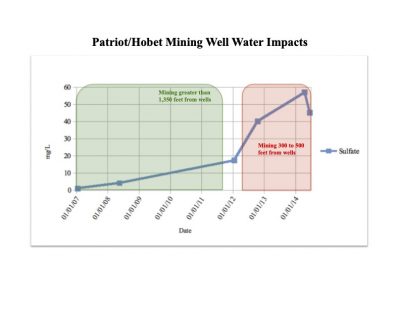Front Porch Blog

Photograph of the Hobet mine taken during a 10-day notice inspection.
The federal surface mining agency has proposed a new rule that, if finalized, will restore community members’ ability to ensure coal companies follow the law.
The Surface Mining Control and Reclamation Act protects communities and the environment from adverse impacts of coal mining in several ways — by imposing requirements for mining operations and reclamation of the land after mining, by creating the Office of Surface Mining Reclamation and Enforcement to oversee coal companies, and by empowering community members to make sure the law is enforced. Under the law, citizens can file lawsuits for violations of SMCRA. Another procedure for community member participation in enforcement is known as the “10-day notice procedure.”
SMCRA states that when the secretary of the Interior is informed by any person of a coal mining violation, the secretary shall notify the regulatory authority, which then has 10 days to take action to correct the violation. Violations can include polluted water running off a mine or a company’s failure to regrade and revegetate land after mining. In practice, when a community member identifies a violation at a coal mine and the state agency has not taken appropriate action to address the violation, the community member can notify OSMRE. Then the state agency would have 10 days to properly address the violation, or OSMRE would step in to ensure the violation is addressed.
Support community oversight of surface mines!
In 2020, under the Trump administration, OSMRE issued a rule to change some key portions of how the 10-day notice procedure is implemented. First, it allowed OSMRE to request additional information from state mining agencies before performing an inspection. This created unnecessary delays in oversight. Second, it exempted systemic violations by state regulators — such as issuing a defective permit that violates the law — from the 10-day notice procedure. These changes allowed state regulatory agencies to evade accountability for coal mining issues identified by community members.
In early 2021, Appalachian Voices, Citizens’ Coal Council and the Sierra Club challenged the Trump-era rule in court. The rule violated SMCRA by creating likely delays beyond 10 days before OSMRE would undertake an inspection and by sidestepping the process entirely for systemic violations by regulatory agencies. OSMRE also failed to conduct an environmental analysis of the proposed rule as required under the National Environmental Policy Act. We asked the court to vacate the portions of the rule that violate SMCRA. The case is still pending.
Now, OSMRE has issued a new rule to address the problems created by the 2020 rule. The proposed rule limits OSMRE to reviewing information provided in the complaint and within the agency’s own files at the time the complaint was submitted, rather than allowing requests for additional data from state regulatory authorities. It treats all community complaints as requests for federal inspection and allows community members to accompany federal regulators on inspections. It includes “permit defects” created by state agencies as matters that can be addressed through the 10-day notice procedure. And it provides stricter timelines and types of actions that qualify as appropriate responses.
The new rule allows for an appropriate balance between community participation, state autonomy and federal oversight. If the proposed rule is finalized in its current form, it will help community members and organizations like Appalachian Voices ensure that mining regulations are enforced.
Sign our petition in support of the new rule!
When community members contact Appalachian Voices regarding likely impacts from mining, we typically investigate the situation ourselves to determine the likelihood of mining impacts. Our coal impacts team has over three decades of combined experience investigating mining impacts to land, rivers and well water. We always encourage community members to notify state agencies of potential violations. When we believe that a state agency has not taken an appropriate and lawful action, we can help community members send a 10-day notice request to OSMRE. Below are some 10-day notice procedures Appalachian Voices has taken part in.
Well water impacts from the Hobet Mine in West Virginia
In 2014, a community member contacted Appalachian Voices regarding a foul smell from a selenium treatment pond at the Hobet Mine in West Virginia. Patriot Coal, the company that owned the mine at the time, had recently installed a bioreactor pond to treat selenium discharging in wastewater from the mine. The smell from the pond was a normal part of the process, where biological organisms such as bacteria are used to help remove selenium from the water.

Discolored water in a residential toilet at the home of a family near the Hobet mine. Mining caused contamination of residential wells.
When I visited the family, I learned that they and several neighbors also had contaminated well water. The water had the distinct rotten egg odor indicative of hydrogen sulfide. The water was also staining their clothes and fixtures orange and often had black particles in it. They had contacted the West Virginia Department of Environmental Protection, but no action had been taken. Luckily, because they had contacted the DEP multiple times over several years and had kept records from the inspection, there was documentation of water quality deterioration as mining moved close to the homes.

[insert graph sent via email]
Red River
In other cases, the 10-day notice procedure has not worked so smoothly. In 2014, my colleague Matt Hepler was working for Southern Appalachian Mountain Stewards and requested a citizen’s inspection of a mine owned by Red River Coal Company. The request was due to a likely illegal discharge of selenium from the mine, which Matt was aware of from publicly available water monitoring data from a nearby stream. The Virginia Department of Mines MInerals and Energy denied Matt’s request for an inspection, stating that the current Clean Water Act permit had no limit for selenium and that the DMME would address the issue when the permit was due for renewal. In response, SAMS sent a 10-day notice request to OSMRE.
OSMRE sampled the wastewater outfall, but did so outside of a formal 10-day notice inspection and did not notify SAMS. The sample taken by OSMRE confirmed that the mine was discharging selenium above the state water quality limit. The OSMRE Knoxville Field Office determined that the DMME had failed to take appropriate action regarding the selenium pollution.
In response, DMME also sampled the wastewater outfall and found a selenium level below the state chronic limit. Based on the single sample taken by the DMME, the OSMRE regional director concluded that there was no violation. The regional director did, however, note that SAMS should have been allowed to attend the OSMRE inspection as requested by the organization.
SAMS then appealed the regional director’s decision to the Interior Board of Land Appeals. Because the chronic selenium limit is based on a monthly average calculation, more than one sample should be taken. The average of the two samples collected by OSMRE and DMME together would have exceeded the chronic allowable level. But the IBLA sided with the regional director regarding the selenium violation, and implied that SAMS did not have a right to attend an inspection because they had not exhausted all available remedies at the state level. This decision threatened to impose a significant hurdle for community members and organizations, because pursuing every available state action before pursuing a 10-day notice procedure would be quite time consuming (and unreasonable).

Matt Hepler finally getting an inspection of a wastewater outfall from the Red River mine.
In 2017, SAMS challenged the IBLA’s decision in federal court and finally won their right to an inspection under the 10-day notice procedure. In the intervening time, the DMME had issued a new Clean Water Act permit for the mine, which made it more difficult to pursue a citizen legal suit regarding the pollution, but did impose monitoring requirements on the mine.
Conclusion
As demonstrated by the two situations above, even prior to the 2020 change that weakened the 10-day notice process, the outcome of the process could vary significantly. We always hope that community enforcement will proceed as it did during the Hobet case — a community member gets a little help organizing and presenting their complaint and OSMRE ensures that appropriate enforcement and remediation takes place. But in other cases, as with Red River, the process may become so convoluted that the average community member is likely to give up. We hope that the new proposed 10-day notice rule helps to make the process accessible and effective for community enforcement.
Please consider signing onto our letter in support of finalizing the new rule!
PREVIOUS
NEXT

Leave a comment
Your email address will not be published. Required fields are marked *

Leave a Comment